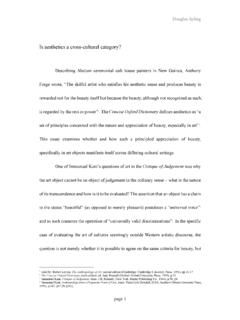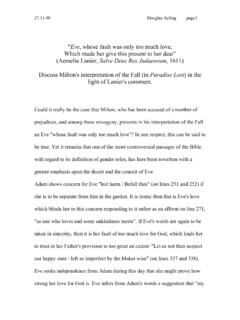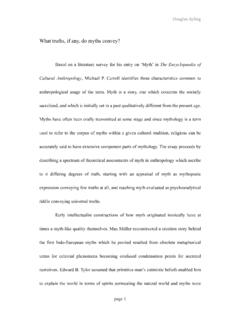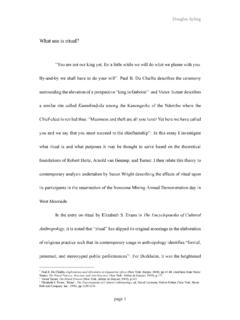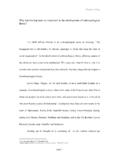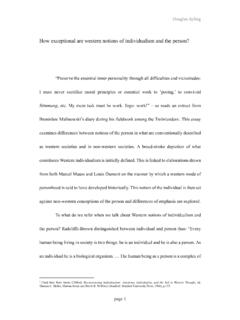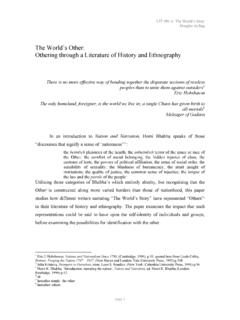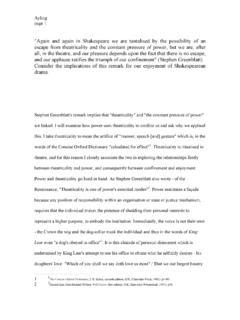Transcription of Are witchcraft beliefs irrational - Douglas Ayling
1 Douglas Ayling page 1 are witchcraft beliefs irrational ? I see witch beliefs as the standardised nightmares of a group , wrote Monica Wilson1. The OED defines irrational as Contrary to or not in accordance with reason 2. As will become clear in a survey of witchcraft , witchcraft beliefs can appear irrational because they posit causal relations which can not be proven (or disproven). In context, this apparent strangeness of witchcraft beliefs does diminish, perhaps most strikingly from a functionalist perspective. The definition of reason is contentious. One approach to a definition suggests that it should involve logic: The power of the mind to think, understand, and form judgements logically 3.
2 On this charge Evans-Pritchard notes that among the Azande, whilst he is adept as showing the rationale behind their practices, Zande understandings about the unilinear transmission of witchcraft substance are not logically extended. It should be the case that if a man is proven a witch the whole of his clan are ipso facto witches, since the Zande clan is a group of persons related biologically to one another through the male line . As an example of illogicality in witchcraft beliefs this is emblematic of a trait remarked by Lucy Mair. She writes, the corpus of witchcraft lore 1 Monica Wilson, Witch beliefs and Social Structure , American Journal of Sociology (1951), ; cited here from Lucy Mair, witchcraft (London: Weidenfeld and Nicolson, 1969), 2 Oxford English Dictionary Online, second edition (1989), available at: < >, retrieved 26th April 2005 3 The Concise Oxford Dictionary, tenth edition, ed.
3 Judy Pearsall (Oxford: Oxford University Press, 1999), Douglas Ayling page 2 does not form a logical whole. Rather, it provides a range of ideas which can be invoked in different situations 4. Thus a man seeking protection against future dangers will subscribe to the idea that he can outwit a witch, whereas during suffering, it is not implausible that the same man will be more likely to dwell on those theories that ascribe almost invincible cunning to witches 5. It is precisely because the corpus allows for elasticity, internal contradiction and illogicality that witchcraft beliefs can retain both their explanatory power and their credibility.
4 Thus Evans-Pritchard writes of the Azande, regarding the unilinear inheritance of witchcraft that, Azande see the sense of the argument but they do not accept its conclusions, and it would involve the whole notion of witchcraft in contradiction were they to do so 6. In practice, the illogical parts of witchcraft beliefs are overlooked for the sake of preserving its explanatory power. Mair comments of diviners that however many individual practitioners are discredited for example, their extraction of harmful substances shown to be a trick people continue to believe that reliable diviners exist, if they could only be found7.
5 She observes that people in distress must be able to think that there is somebody somewhere who can help them, and the greater the 4 Lucy Mair, witchcraft (London: Weidenfeld and Nicolson, 1969), 5 Mair (1969), 6 Evans-Pritchard, witchcraft , Oracles and Magic among the Azande (Oxford: Oxford University Press, 1937), 7 Mair (1969), Douglas Ayling page 3 distress the readier they are to rely on the nearest help that is available 8. Desperation in the search for hope is therefore said to promote complicity in overlooking the illogical. Conversely, there are elements of witchcraft beliefs that cannot be considered illogical.
6 Evans-Pritchard and Mair both argue relativistically for the internally consistent quality of witchcraft beliefs which given the emic technical understandings of the world as starting points have been derived in a logical manner. Universal to witchcraft beliefs are three factors which Mair would term the only functionally necessary ones9. witchcraft accusations presuppose that people are in contact with each other, they must believe that ill-will can harm them and that such harm can operate without physical proximity. On these foundations, and in order to account for unjust suffering in the world ( the problem of evil ), it is arguably quite reasonable to attribute misfortune to disturbances in the social field.
7 What Evans-Pritchard makes clear is that witchcraft is not an attempt to explain what causes a granary to collapse in a Zande homestead, nor does it explain why people sit underneath granaries what witchcraft beliefs can illuminate is why the two chains of causation intersected at a certain time and in a certain place 10. Reason in the post-enlightenment sense treats these two events as independent and cannot account for their coincidence. Similarly the question is asked of an accidental night-time fire started 8 ibidem., 9 ibid., 10 Evans-Pritchard (1937), Douglas Ayling page 4 by a Zande checking on his beer: given that such use of a handful of lit straw held aloft for lighting is standard and regular practice in Zandeland, Why then should this particular man on this single occasion have ignited the thatch of his hut?
8 11. witchcraft constitutes a rational answer in as much as that it provides an answer internally consistent and logically induced from accepted premises. As well as stressing that witchcraft explains misfortune but not phenomena for the Azande, Evans-Pritchard contextualises these beliefs within other socially relevant 12 causes. If a man is killed by an animal, by sickness or in war, witchcraft functions as a second spear 13 (umbaga) it is the additive causation which explains why death resulted in this case. In this hunting analogy, the first spear the natural cause is conceived as non-fatal. In the instances of adultery, lying, theft, deception of a prince, broken taboos and execution, witchcraft is not deemed to be admissible as a cause, neither is it socially relevant14.
9 Therefore mystical explanations are disregarded in favour of a natural one, if it conflicts with social exigencies expressed in law and morals 15 and in this way, the rationale offered by witchcraft has a socially sanctioned scope. There are further practical limits on the influence of mystical beliefs . Whereas witchdoctors can be 11 ibid., 12 ibid., 13 ibid., 14 ib., 15 ib., p75. Douglas Ayling page 5 consulted for quick preliminary inquiries, oracles are not sought unless for actionable corroboration of evidence16; for the Azande, the poison oracle is expensive and time-consuming17 the oracular s ance has some of the characteristics of a leisure activity which requires an entire morning in the bush18.
10 It is possible to regard the irrational elements of witchcraft beliefs as functioning with their own inherent logic for the benefit of the group as a whole. This logic need not be consciously grasped suffice that it operates for the preservation and furtherance of the community. Thus Mary Douglas describes how among the Lele of the Kasai, Democratic Republic of Congo (formerly Za re), sorcery beliefs including the practice of a poison ordeal enabled the elders to retain authority over the young, depending on them for work and for war, preventing them from marrying until their 30s and preserving a precarious gerontocracy19.
